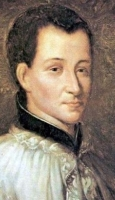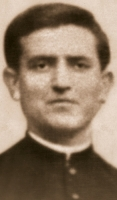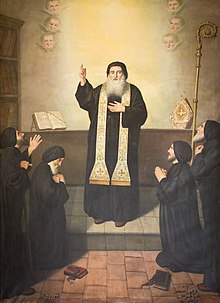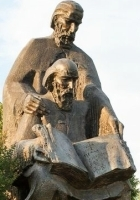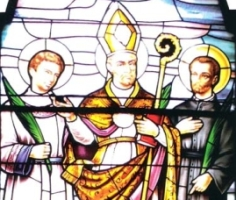Blessed Michal Sopocko
Profile
Michal began his studies at the seminary in Vilnius, Lithuania in 1910, and was ordained a priest in 1914. Parish priest in Vilnius, and military chaplain in World War I from 1914 to 1918, assigned to Vilnius and to Warsaw, Poland. He earned his doctorate in theology in 1926. Spiritual director of the seminary in Vilnius. Professor of pastoral theology at Stefan Batory University in Vilnius in 1928. Beginning in mid-1933, he became the spiritual director and confessor of Saint Faustina Kowalska. He arranged for Eugeniusz Kazimirowski to paint the Divine Mercy image in 1934, in 1935 began preaching on the Divine Mercy, and in 1936 wrote the first booklet about it. From 1942 to 1944, Father Michal was one of many who went into hiding to avoid the occupying Nazi forces. Founded the Zgromadzenie Sióstr Jezusa Milosiernego (Sisters of Merciful Jesus) based on the Divine Mercy messages received by Saint Faustina. In 1959 the Vatican forbade the Divine Mercy devotion and censured Sopocko, but in 1965 Archbishop Karol Wojtyla of Kraków, Poland (future Pope John Paul II) re-opened the investigation of the vision and messages which led to the reversal of the ban and censure in 1978. During the period of the re-investigation, Father Michael wrote the four-volume Milosierdzie Boga w dzielach Jego (Mercy of God in His works).
Born
1 November 1888 in Juszewszczyzna, Ashmyany, Poland
Died
• 15 February 1975 in Bialystock, Poland of natural causes
• buried in Bialystock
• re-interred in the Church of Divine Mercy in Bialostoczek, Poland in 1988
Beatified
• 28 September 2008 by Pope Benedict XVI
• beatification celebrated at the Square of the Sanctuary of the Divine Mercy in Bialystok, Poland by Cardinal Angelo Amato
Patronage
Bialystok, Poland
Saint Claude de la Colombiere
புனிதர் கிளாடி டி லா கொலொம்பியெர்
அருட்பணியாளர், குரு, ஒப்புரவாளர்:
பிறப்பு: ஃபெப்ரவரி 2, 1641
புனித சிம்போரியன்-டி'ஓஸோன், டௌஃபின், ஃபிரான்ஸ் அரசு
இறப்பு: ஃபெப்ரவரி 15, 1682 (வயது 41)
பாரே-லி-மோனியல், பர்கண்டி, ஃபிரான்ஸ் அரசு
ஏற்கும் சமயம்:
கத்தோலிக்க திருச்சபை (இயேசு சபை)
முக்திபேறு பட்டம்: ஜூன் 16, 1929
திருத்தந்தை பதினோறாம் பயஸ்
புனிதர் பட்டம்: மே 31, 1992
திருத்தந்தை இரண்டாம் ஜான் பால்
முக்கிய திருத்தலம்:
இயேசுசபை தேவாலயம், பாரே-லெ-மோனியல், சவோனே-ஏட்-லோய்ர், ஃபிரான்ஸ்
பாதுகாவல்:
இயேசுவின் திருஇருதய பக்தி
நினைவுத் திருநாள்: ஃபிப்ரவரி 15
இன்றைய புனிதராக நினைவுகூறப்படும் புனிதர் "கிளாடி டி லா கொலொம்பியெர்" இயேசு சபையைச் சார்ந்தவர் என்பதால், இயேசு சபையைச் சேர்ந்த துறவியர் மற்றும் குருக்களுக்கு இன்றைய தினம் ஒரு விஷேச தினமாகும். கிளாடி தமது சிநேகிதியும் ஆன்மீக துணையுமான "புனிதர் மார்கரெட் மேரி அலகோக்யூ'வுடன்" (Saint Margaret Mary Alacoque) இணைந்து இயேசுவின் திருஇருதய பக்தியை பரப்பும் முயற்சியில் ஈடுபட்டிருந்தார். ஆகவே, இயேசுவின் திருஇருதயத்தின்பால் தீவிர பக்தி கொண்டுள்ளோர்க்கும் இன்றைய தினம் ஒரு விஷேட தினமாகும்.
இவர் ஒரு இயேசு சபை குருவும், அருட்பணியாளரும், ஒப்புரவாளரும், துறவறம் சார்ந்த எழுத்தாளருமாவார்.
1641ம் ஆண்டு, ஃபிரான்ஸ் அரசின் (Kingdom of France) பண்டைய "டௌஃபின்" (Province of Dauphiné) பிராந்தியத்தில் பிறந்த கிளாடியின் தந்தை "பெர்ட்ரான்ட்" (Bertrand de la Colombière) ஒரு பத்திர சான்றளிக்கும் அலுவலர் ஆவார். தாயாரின் பெயர், "மார்கரெட்" (Margaret Coindat) ஆகும். இவர்களது குடும்பம் விரைவிலேயே அருகாமையிலுள்ள நகரான "வியன்னா"வுக்கு (Vienne) புலம்பெயர்ந்து சென்றது. அங்கே கிளாடி தமது ஆரம்ப கல்வியை தொடங்கினார்.
1658ம் ஆண்டு, தமது பதினேழாம் வயதில் கிளாடி "அவிக்னான்" (Avignon) என்ற இடத்திலுள்ள இயேசு சபையின் துறவறப் புகுநிலையில் (Novitiate) இணைந்தார். துறவறப் புகுநிலை கல்வியை இரண்டு வருடங்களில் முடித்த கிளாடி, உயர் கல்வியையும் அதே நகரிலேயே தொடங்கினார். அதன் பின்னர், தமது பிரதிநிதித்துவத்தை அதே கல்லூரியில் இலக்கணம் மற்றும் இலக்கியம் ஆகியனவற்றை கற்பிப்பதில் ஈடுபடுத்தினார்.
"கிளேர்மான்ட்" (College de Clermont) கல்லூரியில் இறையியல் கற்பதற்காக 1666ம் ஆண்டு, கிளாடி பாரிஸ் நகர் அனுப்பப்பட்டார். அங்கே இறையியல் படிப்பை பூர்த்தி செய்ததும் குருத்துவ அருட்பொழிவு செய்யப்பட்டார். பின்னர் முதன்முதலாக "லியான்" (Lyon) நகரிலுள்ள இவரது முன்னாள் பள்ளியில் கற்பிக்க பணி நியமனம் பெற்றார். அதன்பின்னர், அவர் இயேசு சபையின் மறை பரப்பும் குழுவினருடன் இணைய அறிவுறுத்தப்பட்டார். அங்கேதான் அவரது பிரசங்கிக்கும் திறனும் வலிமையையும் வெளிப்பட்டது.
1676ம் ஆண்டு கிளாடி, அப்போதைய இங்கிலாந்து, ஸ்காட்லாந்து மற்றும் அயர்லாந்து நாடுகளின் அரசியான (Queen consort of England, Scotland and Ireland) “மேரி” (Mary of Modena) என்பவரின் போதகராக இங்கிலாந்து நாட்டுக்கு அனுப்பப்பட்டார். ஃபிரான்ஸ் நாட்டிலிருந்தது போலவே இங்கேயும் திறமையான மறை போதகராகவும், ஒப்புரவாளராகவும் செயல்பட்டார். பல சிரமங்களை எதிர்கொண்ட போதிலும், “மார்கரெட் மேரி அலாக்கோவை” (St. Margaret Mary Alacoque) கடிதங்கள் மூலம் வழிகாட்டினார். கிளாடியின் வைராக்கியமான பணிபுரியும் திறனும், இங்கிலாந்தின் பருவநிலையும் சேர்ந்து கிளாடியின் உடல்நிலையை மோசமாக்கின. அவர் மிகவும் பலவீனமடைந்ததுடன் சுவாசக் கோளாறு நோய்களால் பாதிக்கப்பட்டார். இதன்காரணமாக, அவரது பணிகள் இங்கிலாந்து நாட்டில் முடிவுக்கு வந்தன.
1678ம் ஆண்டு, நவம்பர் மாதம், ஃபிரான்ஸ் நாட்டுக்கு திரும்பிச் செல்ல அழைக்கும் உத்தரவுக்காக காத்திருந்த வேளையில், சட்டென அவர் கைது செய்யப்பட்டு சிறையில் தள்ளப்பட்டார். ஆங்கிலேய அரசுக்கு எதிராக திருத்தந்தை சார்பாக சதி புரிவதாக குற்றம் சாட்டப்பட்டார். கத்தோலிக்க எதிர்ப்பு வெறியார்களால் பிடிக்கப்பட்டு கடுமையான நிலைமைகளில் சிறைப்படுத்தப்பட்டார். இதன்காரணமாக இவரது ஆரோக்கியம் மேலும் சீர்கெட்டது.
ஃபிரான்ஸ் மன்னர் பதினான்காம் லூயிஸின் (King of France, Louis XIV) தலையீட்டால் மரண தண்டனையின்றி தப்பிய கிளாடி, உடனடியாக 1679ம் ஆண்டு, ஃபிரான்ஸுக்கு நாடு கடத்தப்பட்டார். சிறை வாழ்க்கையின் கோர பிடியினால் மோசமாக பாதிக்கப்பட்டிருந்த கிளாடி ஃபிரான்ஸ் திரும்பினார்.
தமது வாழ்க்கையின் கடைசி இரண்டு வருடங்களை "லியோன்" (Lyon) நகரில் செலவிட்ட கிளாடி, இரத்த ஒழுக்கு (Hemorrage) காரணமாக 1682ம் ஆண்டு, ஃபெப்ரவரி மாதம், 15ம் நாளன்று மரணமடைந்தார்.
திருத்தந்தை ஃபிரான்சிஸ் அவர்கள், கடவுளின் அன்புக்கும் இரக்கத்துக்கும் மிக அழகாக முக்கியத்துவம் தருபவர் என்பதாலும், கிளாடி ஒரு சக இயேசு சபையினராகவும், இயேசுவின் திருஇருதய பக்தியை தீவிரமாக பரப்பியவர் என்பதாலும் கிளாடி அவருக்கு மிகவும் விசேடமானவர் எனலாம். மற்றும், கடவுளின் அன்புக்கும், இரக்கத்துக்கும் முக்கியத்துவம் தருவது இவ்விருவரின் சிறப்புப் பண்பாகும்
Also known as
Claudio, Claudius
Profile
Born to the French nobility, Claude early felt a call to religious life. Educated at Jesuit college in Lyons, France. Priest. Taught humanities at Avignon, France. Continued his studies in Paris, France. Tutor. Preached against Jansenism, advocating dedication to the Sacred Heart of Jesus. Joined the Jesuits in 1659. Spiritual director of Saint Margaret Mary of Alocoque.
Chaplain to Mary Beatrice d'Este, the Duchess of York. He converted many Protestants through the example of his holy life. Due to rumours of "Popish plots" against the king and the re-establishment Catholicism, Claude was imprisoned, accused of being part of the Titus Oates Plot. It was only by the efforts of Louis XIV, who had recommended him for the assignment, that he was not martyred. Banished from England. His health had been ruined by his time in prison, and he returned to Paray to die. The day after his death, Saint Margaret received supernatural assurance that Claude needed no prayers, as he was in already heaven. He is considred a "dry" martyr, having suffered every abuse for the faith except death.
Born
2 February 1641 at Saint-Symphorien d'Ozon, Rhône, France
Died
15 February 1682 at Paray-le-Monial, Saône-et-Loire, France of hemoptysis (coughing up blood)
Canonized
31 May 1992 by Pope John Paul II in Rome, Italy
Patronage
• toy makers
• turners
Saint Sigfrid of Sweden
Also known as
• Apostle of Sweden
• Sigfrid of Vaexjoe
• Sigfrid of Växjö
• Sigfrid of Wexlow
• Sigfried, Siegfried
Profile
Priest at York and/or Glastonbury in England. Monk. Evangelized in Norway, Sweden, Denmark. Brought King Olaf of Sweden to the faith. While Sigfrid was away on a mission, his three nephews (Saint Winaman, Saint Unaman, and Saint Sunaman), who had come to help with the work in Sweden, were beheaded by pagan raiders. Sigfrid returned, recovered their heads, and claimed they could talk, a claim that terrorized the pagans. King Olaf decided to execute the murderers, but Sigfrid spoke against capital punishment and the killers were spared. Olaf then ordered them to pay a large fine, but Sigfrid refused the blood money, and thus achieved such a moral high ground that his mission work became even more successful.
Born
at Glastonbury, England
Died
c.1045 at Vaexjoe, Sweden
Canonized
by Pope Adrian IV
Patronage
• Sweden
• Götaland, Sweden
Saint Onesimus the Slave
Also known as
Onesimo
Profile
Slave of the Colossian Christians Saint Philemon and Saint Apphia. Committed a theft and fled from punishment to Rome where he hid with Saint Paul the Apostle. Paul converted him, then sent him home carrying the canonical Letter to Philemon. He was freed.
Died
c.90
Blessed Gregorio Díez Blanco
Profile
Baptized on the day he was born, and Confirmed in 1903. As a young man, he moved to Barcelona, Spain and worked for a tram company. Married to Paulina Díez Anidobro, and the father of four. Paulina died on 24 March 1930, and Gregorio’s sister, Blessed Camila Díez Blanco, moved in to help with the children. Friend of Blessed Eliseo Moradillo García. When the Spanish Civil War began, Gregorio sheltered any religious who were hiding from anti–Catholic forces, and drew the attention of those forces when he tried to obtain the release of some religious brothers from Sant Feliu prison. This ministry led to his arrest and martyrdom with Eliseo and Camila.
Born
24 December 1899 in Nidáguila, Burgos, Spain
Died
15 February 1937 in Barcelona, Spain
Beatified
• 10 November 2018 by Pope Francis
• beatification celebrated in the Basilica of Sagrada Familia in Barcelona, Spain, presided by Cardinal Giovanni Angelo Becciu
Saint Walfrid
Also known as
Galfrido, Gualfredo, Gualfredus, Qualfredo, Qualfredo della Gherardesca, Valfred, Vilfrid, Walfridus, Wilfrido, Walfredo
Profile
Eldest of five children in a wealthy family. Properous married layman, a solid citizen, and father of five sons and a daughter. With their children grown, he and his wife, Thesia, each felt called to religious life. Walfrid and two married friends, Fortis and Gunduald, founded the Benedictine monastery of Palazzuolo, and a nearby convent for their wives and Walfrid's daughter. Walfrid served as abbot of the house, and the monastery was soon home to 60 monks.
Walfrid's son later entered the monastery, became a priest, had a terrible lapse of behavior and faith, reconciled with the monastery and the Church, and served as the second abbot. Gundual's son enterd the monastery, served as third abbot, and wrote a biography of Walfrid.
Born
8th century Pisa, Italy
Died
• 15 February 765 at Palazuollo, Italy of natural causes
• buried nearby with his wife, Thesia
Canonized
1861 by Pope Blessed Pius IX (cultus confirmed)
Saint Jovita
தூய ஃபாஸ்டினுஸ் மற்றும் தூய ஜோவிட்டா
படைப்பு முழுவதற்கும் அவர் தம் இரக்கத்தை வெளிப்படுத்தினார் (சீஞா 16:16)
ஃபாஸ்டினுஸ் மற்றும் ஜோவிட்டார் இருவரும் இத்தாலியில், லம்பார்தேயில் உள்ள ப்ரசியா என்னும் இடத்தைப் பிறப்பிடமாகக் கொண்டவர்கள். உடன் பிறந்த சகோதரர்கள். முதலாமவர் குருவாக இருந்தார் .இரண்டாமரோ திருத்தொண்டராக இருந்தார். பாரம்பரியத் தகவல்களின்படி இருவருமே தீவிரமாக நற்செய்தியைப் போதித்து கிறிஸ்துவை மற்றவர்கள் அறியச் செய்வதில் முனைப்புக் காட்டினார்கள் என்பது தெரிகிறது.
கிறிஸ்தவர்களைக் கொன்றழித்து ஆனந்தம் அடைந்த அரசர்களை மகிழ்விக்க ஆளுநர்களும் கங்கனம் கட்டிச் செயல்பட்டார்கள். அப்படியான ஆளுநர்களுள் ஒருவரான ஜூலியன் இச்சகோதரர்கள் இருவரையும் கைது செய்தான் .துன்புறுத்தி குதூகலித்தான். ப்ரசியாவிலிருந்து பிலான் நகருக்கும் அங்கிருந்து உரோமைக்கும், பிறகு நேப்பிள்ஸ் பகுதிக்கும் மீண்டும் ப்ரசியாவுக்கும் இருவரையும் கட்டி இழுத்துச் சென்றான்.
அப்போது யதார்த்தமாக அந்தப்பக்கமா வந்து பேரரசர் அட்ரியன் இருவரைப் பற்றியும் விசாரித்தான் .இதைக் குறித்து, அப்போது பேரரசன் அட்ரியனுடன் ப்ரசியாவுக்கு வந்திருந்த புனித கலாசெருஸ் எழுதியுள்ளார் .இவர் ப்ரசியாவைத் தாய் மண்ணாகவும், பேரரசர் அட்ரியன் அரசவையில் அதிகாரியாகவும் இருந்தவர்.
விசாரணையின்போது சூரியனை வணங்கும்படி கட்டளை பிறப்பித்தான் பேரரசன் . அதை மறுத்து, "உலகிற்கு ஒளிதர சூரியனைப் படைத்த இறைவனைத் தவிர வேறொன்றையும் வணங்க மாட்டேன் " என்று ஃபாஸ்டினுஸ் துணிச்சலுடன் பதிலுரைத்தார்.
தாங்கள் நிறுத்தி வைக்கப்பட்டிருந்த இடத்திற்கு முன்பாக இருந்த சிலை ஒளிரும் படி வடிவமைக்கப்பட்டிருந்ததைக் கவனித்த ஜோவிட்டா "விண்ணகத்திலிருந்து ஆட்சி செய்யும் இறைவனையே நாங்கள் வணங்குகிறோம். அவரை சூரியனைப் படைத்தார். நீங்களும் இந்த சிலையும் கருகிப்போவீர்கள். இதை வணங்கும் அனைவருக்கும் அவமானமே வந்து சேரும்" என்று ஒளிபடைத்த கண்ணினனாக முழங்கினார்.
உடனேயே அச்சிலை கறுத்துப்போனது. அங்கு நின்றிருந்த பூசாரிகளை அனுப்பி சிலையைச் சுத்தம் செய்யும்படி அரசன் கட்டளையிட்டான். பயந்து நடுங்கி தயங்கியபடியே அவர்கள் சென்றார்கள். சென்று அச்சிலையைத் தொட்டதும் அது சாம்பல் போல உதிர்ந்து விழுந்தது.
கோபத்தின் உச்சத்திற்குப் போன பேரரசன் பசியோடும் பட்டினியோடும் வளர்க்கப்பட்டிருந்த சிங்கங்களுக்கு இரையாக்கு வதற்காக அதன் குகைகளுக்கு இருவரையும் இழுத்துச் செல்ல கட்டளையிட்டான் . அதன்படியே வீரர்கள் செய்தார்கள். குகையின் கதவுகள் திறக்கப்பட்டன. சிங்கங்கள் பாய்ந்து வந்தன. பாய்ந்து வந்த சிங்கங்கள் அவர்கள் முன் மண்டியிட்டு பணிந்து நின்றன. இதை நேரில் பார்த்த புனித கலாசெருஸ் உண்மைக் கடவுளை நம்பித் தன்னோடு 12 ஆயிரம் மக்களைச் சேர்த்துத் திருமுழுக்குப் பெற்ற கிறிஸ்தவரானார்.
பிறகு இருவரையும் சிறையில் அடைத்து உணவும், நீரும் கொடுக்காது பட்டினி போட்டு கொல்லத் தயாரானார்கள். சிறையில் இருந்தபோது வானதூதர்கள் வந்து இருவரையும் திடப்படுத்தினார்கள். பயம் போக்கி மகிழ்ச்சி அளித்தார்கள் .அந்த அறை முழுவதும் நிறைந்திருந்த ஒளியைப் பார்த்த எண்ணற்றோர் கத்தோலிக்க கிறிஸ்தவர்கள் ஆனார்கள். நிறைவில் இருவரும் தலை வெட்டப்பட்டு மறைசாட்சி ஆனார்கள். இது 120 ஆம் ஆண்டில் நடந்தது.
தங்கள் நாட்டின் முதன்மைப் பாதுகாவலராக வைத்த இவர்களிடம் மன்றாடுவதுடன், இவர்களின் புனிதப் பொருள்களையும் ப்ரசியா மக்கள் பாதுகாத்து வருகிறார்கள்.
ஒளிரும் இறைவனின் திரு முக தரிசனத்தை படைப்பு அனைத்திலும் தேடுவோர் அவை சொல்லும் வாழ்விற்கான இறை நற்செய்தியைக் கண்டுகொள்ள முடியும்.
Profile
Born to the nobility in 2nd century Italy, the younger brother of Saint Faustinus. Deacon. Zealous preacher in Brescia, Milan, Rome, and Naples. Tortured and martyred in the persecution of Emperor Hadrian.
While their cultus is ancient and widespread, recent scholarship indicates that the story of Jovinus and Faustinus was a pious fiction mistaken for a biography.
Born
• at Brescia, Lombardy, Italy
• Credera Rubbiano, Italy
Died
• with his brother, he was thrown to the lions, but the animals refused to touch the men
• beheaded in 120 at Brescia, Italy
• relics reported in Brescia, Rome, Verona, and Bologna
Patronage
• Brescia, Italy, city of
• Brescia, Italy, diocese of
• Credera Rubbiano, Italy
• Magreta, Italy
Saint Quinidius of Vaison
Also known as
Quinidio, Quinis
Profile
Known in his youth as an excellent student. Studied theology at Lerins Abbey. Travelling preacher through the areas of Avignon, Brignoles, Besse, Gonfaron in France, converting many. Hermit in Aix-en-Provence, France. Arch-deacon and then bishop of Vaison, France in 570; he spent much of his time as bishop ministering to people in the street, caring for children, the elderly, and people who were sick or neglected.
Born
early 6th century in Vaison-la-Romaine, Vaucluse (in modern France)
Died
• c.579 in Vaison-la-Romaine, France of natural causes
• relics enshrined in a in Gonfaron in the late 6th century
• the chapel was destroyed in the religious wars of the 16th century
• relics enshrined in a new chapel built by the Trinitarians in 1634
Saint Faustinus
Profile
Born to the nobility in 2nd century Italy, the older brother of Saint Jovinus. Priest. Zealous preacher in Brescia, Milan, Rome, and Naples. Tortured and martyred in the persecution of Emperor Hadrian.
While their cultus is ancient and widespread, recent scholarship indicates that the story of Jovinus and Faustinus was a pious fiction mistaken for a biography.
Born
at Brescia, Lombardy, Italy
Died
• with his brother, he was thrown to the lions, but the animals refused to touch the men
• beheaded in 120 at Brescia, Italy
• relics reported in Brescia, Rome, Verona, and Bologna
Patronage
• Brescia, Italy, city of
• Brescia, Italy, diocese of
• Credera Rubbiano, Italy
• Magreta, Italy
Blessed Camila Díez Blanco
Profile
Baptized on the day she was born, and Confirmed in 1892. In March 1930 she moved in with her recently widowed brother, Blessed Gregorio Díez Blanco, raise his four children. When the Spanish Civil War began, Camila and Gregorio sheltered religious who were hiding from anti–Catholic forces. Friend of Blessed Eliseo Moradillo García. On 15 February 1937, a group of militiamen raided her home, detained and later executed Camila, Eliseo and Gregorio. Martyr.
Born
14 September 1889 in Nidáguila, Burgos, Spain
Died
15 February 1937 in Barcelona, Spain
Beatified
• 10 November 2018 by Pope Francis
• beatification celebrated in the Basilica of Sagrada Familia in Barcelona, Spain, presided by Cardinal Giovanni Angelo Becciu
Blessed Juan Alonso Fernández
Profile
Juan joined the Missionaries of the Sacred Heart in 1953, making his perpetual vows on 8 September 1958. Ordained a priest on 11 June 1960, he was sent to serve in Guatemala. Missionary to Indonesia from 1963 to 1965. Returning to Guatemala, he founded the parish of San Maria Regina in the town of Lancetillo, and served there until he was seized, tortured and murdered by government forces. Martyr.
Born
28 November 1933 in Cuérigo, Asturias, Spain
Died
shot three times in the head on 15 February 1981 in La Barranca, Quiché, Guatemala
Beatified
• 23 April 2021 by Pope Francis
• beatification recognition celebrated in Santa Cruz del Quiché, Guatemala
Saint Euseus of Serravalle-Sesia
Also known as
Euseo
Profile
Shoemaker in the area of 13th – 14th century Serravalle-Sesia, Italy who lived as a prayerful hermit.
Died
• 14th century, year unknown, at home in Serravalle-Sesia, Vercelli, Italy of natural causes
• his death was discovered when people going to the last day of Carnavale, Whit Monday, saw three lilies blooming above his hermit‘s hut in winter, considered it miraculous and investigated what was happening there
• he was buried at his hut, and a church was soon built over his grave
Patronage
• cobblers, shoemakers
• Serravalle-Sesia, Italy
Blessed Acacio Calleja Santamaría
Also known as
Brother Acacio María
Profile
Baptized at the age of 2 days. Member of the Congregation of Saint Peter ad Vincula, making his profession in 1934 in Marseille, France. Studied humanities and philosophy in Barcelona, Spain. Known for his love of his vocation and his care for the students he taught. Martyred in the Spanish Civil War.
Born
7 May 1915 in Yudego, Burgos, Spain
Died
15 February 1937 in Barcelona, Spain
Beatified
• 10 November 2018 by Pope Francis
• beatification celebrated in the Basilica of Sagrada Familia in Barcelona, Spain, presided by Cardinal Giovanni Angelo Becciu
Blessed Ricardo Guerra-Villazan
Also known as
Brother Albino
Profile
Baptized at the age of three days. Member of the Congregation of Saint Peter ad Vincula, making his novitiate in Marseille, France and his profession in 1931. After studies in Barcelona, Spain, he received a degree in theology. Martyred in the Spanish Civil War.
Born
14 September 1913 in Arenillas de Riupisuerga, Burgos, Spain
Died
shot on 15 February 1937 in Barcelona, Spain
Beatified
• 10 November 2018 by Pope Francis
• beatification celebrated in the Basilica of Sagrada Familia in Barcelona, Spain, presided by Cardinal Giovanni Angelo Becciu
Blessed Eliseo Moradillo García
Profile
Baptized at the age of six days, Eliseo and his family moved often in his childhood as his father worked for the railroad and was constantly transferred. Friend of Blessed Camila Díez Blanco and Blessed Gregorio Díez Blanco. He was in their home on 15 February detained and later executed. Martyr.
Born
10 September 1906 in Celada del Camino, Burgos, Spain
Died
15 February 1937 in Barcelona, Spain
Beatified
• 10 November 2018 by Pope Francis
• beatification celebrated in the Basilica of Sagrada Familia in Barcelona, Spain, presided by Cardinal Giovanni Angelo Becciu
Blessed Ángel de la Iglesia Ociña
Profile
Baptized on the day he was born. Joined the Congregation of Saint Peter ad Vincula in 1926 in Marseille, France, making his profession on 11 October 1931. Studied at and received a degree in theology in Barcelona, Spain in 1936. Martyred in the Spanish Civil War.
Born
1 October 1913 in Nidáguila, Burgos, Spain
Died
15 February 1937 in Barcelona, Spain
Beatified
• 10 November 2018 by Pope Francis
• beatification celebrated in the Basilica of Sagrada Familia in Barcelona, Spain, presided by Cardinal Giovanni Angelo Becciu
Blessed Angelus de Scarpetti
Also known as
• Angelus of Borgo San Sepolcro
• Angelus of Sansepolcro
• Angelo...
Profile
Augustinian friar c.1254. Fellow student with Saint Nicholas of Tolentino. Missionary to England where he preached and built monasteries. Known as a miracle worker. He once intervened on behalf of a man condemned to death; the authorities ignored him, and executed the man; Angelus then promptly brought the man back to life.
Born
at Borgo San Sepolcro (modern Sansepolcro), Italy
Died
c.1306 at Borgo San Sepolcro (modern Sansepolcro), Italy
Beatified
27 July 1921 by Pope Benedict XV
Saint Berach of Kilbarry
Also known as
• Berach of Cluain
• Berach of Termonbarry
• Barachias, Barry, Berachius
Profile
Brother of Saint Midabaria. Raised by his uncle, Saint Freoch. Spiritual student of Saint Kevin of Glendalough. Built a church and monastery at Cluain Coirpthe, also known as Termonbarry or Kilbarry, Ireland. Believed to be a martyr. His crosier is in the Dublin Museum.
Died
martyred in 595
Patronage
Kilbarry, Ireland
Blessed Pere Vallmitjana Abarca
Profile
Priest. Member of the Benedictine Subiaco Congregation. Martyred in the Spanish Civil War.
Born
19 May 1875 in Barcelona, Spain
Died
15 February 1937 in Cerdanyola, Barcelona, Spain
Beatified
• 13 October 2013 by Pope Francis
• beatification celebrated in Tarragona, Spain
Saint Georgia
புனித_ஜார்ஜியா (-500)
பிப்ரவரி 15
இவர் (#StGeorgia) பிரான்சில் பிறந்தவர். சிறுவயது முதலே தன்னை ஆண்டவருக்கு அர்ப்பணித்து வாழ்ந்த இவர், தன் வாழ்வின் பெரும் பகுதியை கோயிலிலேயே செலவழித்து, இறைவேண்டலில் நிலைத்திருந்தார்.
இவர் மூப்படைந்து இறந்தபோது, எங்கிருந்த வந்த புறாக்கள் கூட்டம், இவரது இறுதிப் பயணத் திருப்பலி நடந்த கோயில் உச்சியில் அமர்ந்து கொண்டு, திருப்பலி நிறைவேறும் வரை அங்கேயே இருந்தது.
இதைப் பார்த்துவிட்டு மக்கள் இவர் உண்மையாகவே இறைவனின் அன்புக்குரியவர் என்று நெஞ்சார இறைவனைப் போற்றிப் புகழ்ந்தார்கள்.
Also known as
Giorgia
Profile
Nun. Anchoress near Clermont, France.
Died
• c.500
• legend says that a flock of doves followed her funeral procession to the tomb and then stood watch over it the rest of the day
Blessed Antonio Marini
Profile
Mercedarian friar. He earned a doctorate in theology from the University of Paris. Blessed Antonio was noted for his combination of learning and piety.
Died
at the Santa Eulalia monastery in Montpellier, France of natural causes
Saint Columban of Ghent
Profile
Hermit who lived in the cemetery of the abbey of Saint Bavo in Ghent, Belgium from 957 until his death.
Born
possibly Ireland
Died
• 959 at the Saint Bavon abbey in Ghent, Belgium
• buried in front of the Saint Andrew altar in the Blessed Virgin Mary chapel of the abbey
Saint Farannan of Iona
Profile
Monk of Iona Abbey. Spiritual student of Saint Columba of Iona. Eventually retired to live as a cave hermit at All-Farannan (modern Allernan), in Sligo, Ireland.
Born
6th century Ireland
Died
c.590 in Sligo, Ireland
Patronage
Allernan, Ireland
Saint Joseph of Antioch
Also known as
Josippus
Profile
Deacon. Hymnist. Martyred with seven others whose names have not come down to us during the iconoclast persecutions of emperor Theophilus.
Born
Syria
Died
Antioch, Syria
Saint Severus of Abruzzi
Also known as
Severo
Profile
Priest in the Abruzzi region of Italy. Saint Gregory the Great writes that Severus brought a man back from the dead long enough to receive communion and unction.
Died
c.530
Saint Decorosus of Capua
Also known as
Decoroso
Profile
Bishop of Capua, Italy for 30 years. Assisted at and supported the Council of Rome in 680.
Died
695 of natural causes while at the altar of his church
Saint Agape of Terni
Also known as
Agapes, Agapia
Profile
Spiritual student of Saint Valentine of Terni, and part he led of women devoted to religious life. Martyr.
Died
martyred c.273 in Terni, Italy
Saint Craton
Profile
Professor of rhetoric and philosophy. Convert, brought to the faith by Saint Valentine of Terni. Martyred with his wife and family, none of whose names have survived.
Died
c.273 in Rome, Italy
Saint Sunaman of Sweden
Profile
Nephew of Saint Sigfrid. Monk. Missionary to Sweden with Sigfrid. Martyred by pagans.
Died
c.1040 in Sweden
Saint Winaman of Sweden
Profile
Nephew of Saint Sigfrid. Monk. Missionary to Sweden with Sigfrid. Martyred by pagans.
Died
c.1040 in Sweden
Saint Unaman of Sweden
Profile
Nephew of Saint Sigfrid. Monk. Missionary to Sweden with Sigfrid. Martyred by pagans.
Died
c.1040 in Sweden
Saint Dochow
Also known as
Dochau, Dogwyn
Profile
Immigrated to Cornwall where he founded a monastery. May have become a bishop; records are inconclusive.
Born
Wales
Died
c.473
Saint Faustus of Monte Cassino
Profile
Sixth-century Benedictine monk at Monte Cassino Abbey. Spiritual student of Saint Benedict of Nursia.
Saint Druthmar of Corvey
Profile
Monk at Lorsch. Abbot of Corvey Abbey in 1014.
Died
1046
Saint Eusebius of Asehia
Profile
Fifth century hermit in Asehia, Syria.
Martyrs of Antioch
Profile
A group of Christians murdered together. We know the names of five of them - Agapev, Baralo, Isicio, Joseph and Zosimus.
Martyrs of Passae
Profile
A group of Christians murdered for their faith in the diocese of Saint Valetine in Terni, Italy. We know nothing else about them but the names Castulus, Lucius, Magnus, and Saturninus.
Died
273 in Passae, Italy
Martyrs of Prague
Profile
Franciscan Friars Minor martyred together by a mob led by Lutherans.
• Antonín of Prague
• Bartolomeo Dalmasoni
• Bedrich Bachstein
• Christoffel Zelt
• Didak Jan
• Emmanuel of Prague
• Gaspare Daverio
• Giovanni Bodeo
• Girolamo degli Arese
• Jakob of Prague
• Jan of Prague
• Juan Martínez
• Klemens of Prague
• Simon of Prague
Died
• Shrove Tuesday 15 February 1611 at the Church of Our Lady of the Snows in Prague, Czech Republic
• bodies dumped nearby but given Christian burial on 19 February 1611 in the monastery
• re-interred in the side chapel of the church in 1616
Beatified
13 October 2012 by Pope Benedict XVI
Also celebrated but no entry yet
• Our Lady of Paris


